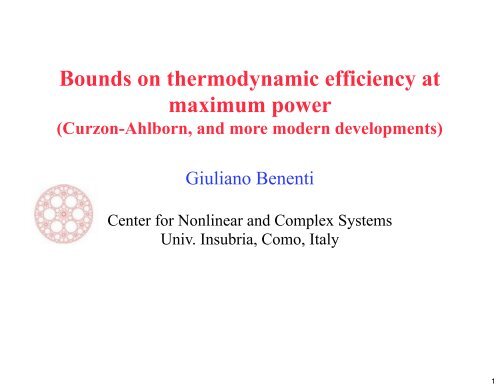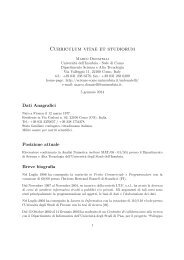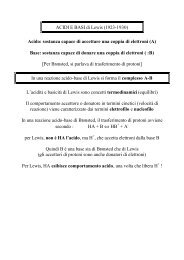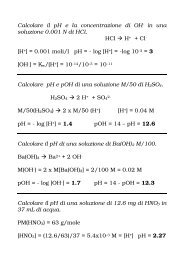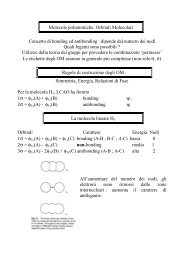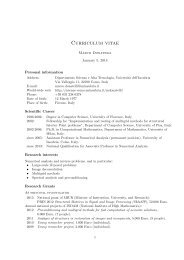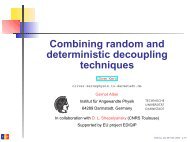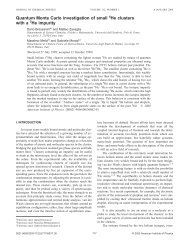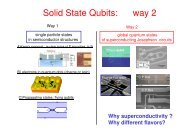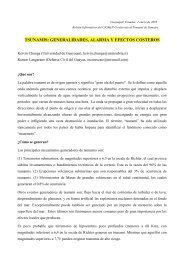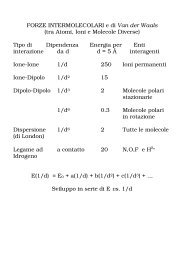Bounds on thermodynamic efficiency at maximum power (Curzon ...
Bounds on thermodynamic efficiency at maximum power (Curzon ...
Bounds on thermodynamic efficiency at maximum power (Curzon ...
Create successful ePaper yourself
Turn your PDF publications into a flip-book with our unique Google optimized e-Paper software.
Finite-time <strong>thermodynamic</strong>sHow much the <strong>efficiency</strong> deterior<strong>at</strong>es when the cycle isoper<strong>at</strong>ed in a finite time? This is the central questi<strong>on</strong> in the fieldof finite-time <strong>thermodynamic</strong>s.Endoreversible <strong>thermodynamic</strong>s: wiews a <strong>thermodynamic</strong>system as a collecti<strong>on</strong> of reversible subsystems which interactin an irreversible mannerMany applic<strong>at</strong>i<strong>on</strong>s: he<strong>at</strong> engines, optimal p<strong>at</strong>hs in chemicalreacti<strong>on</strong>s, in solar energy capture in semic<strong>on</strong>ductor solar cells(or in the chlorophyll of plants), etc. Often, even in n<strong>at</strong>ure,found processes close to <strong>maximum</strong> <strong>power</strong> producti<strong>on</strong> (efficient<strong>power</strong> producti<strong>on</strong>).3
Maximum <strong>power</strong>Assume the time spent in the adiab<strong>at</strong>ic strokes negligible withrespect to the times of the isothermal strokes (fast relax<strong>at</strong>i<strong>on</strong>processes within the working fluid)Output <strong>power</strong>:P = W t= Q 1 + Q 2t= Ξ 1t 1 (T 1 − T 1i )+Ξ 2 t 2 (T 2 − T 2i )The internal Carnot engine has <strong>efficiency</strong>η Ci =1− T 2iT 1i=1+ Q 2Q 1t 1 + t 25
Dur<strong>at</strong>i<strong>on</strong> of isothermal process proporti<strong>on</strong>al to temper<strong>at</strong>uredifferenceQ 1t 1 =Ξ 1 (T 1 − T 1i ) , t Q 22 =Ξ 2 (T 2 − T 2i )Output <strong>power</strong>:By maximizing the <strong>power</strong> with respect to the internaltemper<strong>at</strong>ures we obtain6
Efficiency <strong>at</strong> <strong>maximum</strong> <strong>power</strong>The <strong>efficiency</strong> <strong>at</strong> the <strong>maximum</strong> <strong>power</strong> of the CA engine is givenby the so-called Curz<strong>on</strong>-Ahlborn <strong>efficiency</strong>:η CA =1−T2T 1Quite remarkably, the CA <strong>efficiency</strong> is independent of thethermal c<strong>on</strong>ductances Ξ1 and Ξ2.[Curz<strong>on</strong> and Ahlborn, Am. J. Phys. 43, 22 (1975); Yv<strong>on</strong> (1955);Chambadal (1957), Novikov (1958)]7
CA <strong>efficiency</strong> is not a universal upper bound but reproduces the<strong>efficiency</strong> of real thermal plants quite well(Curz<strong>on</strong> and Ahlborn, 1975)[Esposito, Kawai, Lindenberg, Van denBroeck, PRL 105, 150603 (2010)]8
For a Carnot cycle in the infnite-time cycle, n<strong>on</strong>dissip<strong>at</strong>ivelimit, the system entropy changes during isothermal strokes as∆S = Q 1T 1, −∆S = Q 2T 2In the low dissip<strong>at</strong>i<strong>on</strong> regime entropy producti<strong>on</strong> proporti<strong>on</strong>alto 1/t1 and 1/t2, so th<strong>at</strong> it vanishes in the limit of infinite-timecycleQ 1 = T 1∆S − Σ 1t 1+ ..., Q 2 = T 2 −∆S − Σ 2+ ...t 2From Clausius inequality BA δQTirr< BA δQTrev⇒ Σ 1 , Σ 2 > 09
Output <strong>power</strong>P =Wt 1 + t 2= Q 1 + Q 2t 1 + t 2= (T 1 − T 2 )∆S − T 1 Σ 1 /t 1 − T 2 Σ 2 /t 2t 1 + t 2<strong>maximum</strong> when∂P= ∂P =0∂t 1 ∂t 2This leads tot 1 =2T 1 Σ 1(T 1 − T 2 )∆S1+T2 Σ 2T 1 Σ 1t 210
Efficiency <strong>at</strong> the <strong>maximum</strong> output <strong>power</strong>:η(P max )=1+η C1+T 2 Σ 2T 1 Σ 1 2 T 2 Σ 2T 1 Σ 1+T 2T 11 − Σ 2Σ 1[Esposito, Kawai, Lindenberg, Van den Broeck, PRL 105, 150603(2010); Schmiedl and Seifert, EPL 81, 20003 (2008)]Symmetric dissip<strong>at</strong>i<strong>on</strong> Σ 1 =Σ 2 :η(P max )=η CAΣ 2 /Σ 1 → 0: η(P max )= η C2 − η CΣ 2 /Σ 1 →∞:η(P max )= η C211
Linear resp<strong>on</strong>se steady st<strong>at</strong>e he<strong>at</strong> to work c<strong>on</strong>versi<strong>on</strong>Stochastic b<strong>at</strong>hs: idealgases <strong>at</strong> fixed temper<strong>at</strong>ureand chemical potentialX 1 = β∆µX 2 = −∆β =∆T/T 2β =1/T∆µ = µ 1 − µ 2∆β = β 1 − β 2∆T = T 1 − T 2(we assume T 1 >T 2 ,µ 1
Restricti<strong>on</strong>s from <strong>thermodynamic</strong>sLet us c<strong>on</strong>sider the time-symmetric caseOnsager rel<strong>at</strong>i<strong>on</strong>:Positivity of entropy producti<strong>on</strong>:dSdt = J ρX 1 + J q X 2 ≥ 013
Onsager and transport coefficientsG =Jρ∆µ/e JqΞ=∆T ∆µ/eS =∆T∆T =0J ρ =0J ρ =0⇒G = e2T L ρρ⇒ Ξ= 1T 2 det LL ρρ⇒ S = − 1eTL ρqL ρρ14Note th<strong>at</strong> the positivity of entropy producti<strong>on</strong> impliesth<strong>at</strong> the (isothermal) electric c<strong>on</strong>ductance G>0 and thethermal c<strong>on</strong>ductance Ξ>0
Seebeck and Peltier coefficientsS = ∆µ/e∆TJ ρ =0⇒ S = − 1eTL ρqL ρρΠ=JqeJ ρ∆T =0= L qρeL ρρ= L ρqeL ρρ= TSSeebeck and Peltier coefficients are trivially rel<strong>at</strong>ed byOnsager reciprocal rel<strong>at</strong>i<strong>on</strong>s (when time symmetry isnot broken)15
Steady st<strong>at</strong>e <strong>power</strong> gener<strong>at</strong>i<strong>on</strong> <strong>efficiency</strong>η = W Q 1=(T 1 >T 2 )(µ 1 0,J q > 0)η ≤ η C =1− T 2T 116
Thermoelectric figure of meritZT = L2 ρqdetL = GS2Ξ T 17The <strong>maximum</strong> of η over X1, for fixed X2 (i.e., over theapplied voltage ΔV for fixed temper<strong>at</strong>ure differenceΔT) is (for systems with time-reversal symmetry)
Efficiency <strong>at</strong> <strong>maximum</strong> <strong>power</strong>Within linear resp<strong>on</strong>se, the output <strong>power</strong>P = −TX 1 J ρ = −TX 1 (L ρρ X 1 + L ρq X 2 )is <strong>maximum</strong> whenP18
Maximum output <strong>power</strong>P max = T 4L 2 ρqX2 2 = η CL ρρ 4L 2 ρqL ρρX 2Efficiency <strong>at</strong> <strong>maximum</strong> <strong>power</strong>η(P max )= η C2ZTZT +2Both <strong>maximum</strong> <strong>efficiency</strong> and <strong>efficiency</strong> <strong>at</strong> <strong>maximum</strong><strong>power</strong> are m<strong>on</strong>ot<strong>on</strong>ous growing functi<strong>on</strong>s of thethermoelectric figure of merit ZTη(P max ) → η C2when ZT →∞η CA =1−T1T 2=1− 1 − η C = η C2 + O(η2 C)19
η maxη(P max )20
And when time-reversal is broken?T 1 ,µ 1 BT 2 ,µ 2B applied magnetic field or anyparameter breaking time-reversibilitysuch as the Coriolis force, etc.21
C<strong>on</strong>straints from <strong>thermodynamic</strong>sPOSITIVITY OF THE ENTROPY PRODUCTION:ONSAGER-CASIMIR RELATIONS:22
Efficiency <strong>at</strong> <strong>maximum</strong> <strong>power</strong> depends <strong>on</strong> two parametersη(P max )= η C2xy2+y23
<strong>maximum</strong> η of η(P max )η(P max ) ≤ η = η Cx 2x 2 +124
The Curz<strong>on</strong>-Ahlborn limit can beovercome within linear resp<strong>on</strong>se25


